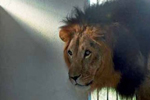
Barbary sheep in Tennoji Zoo. Photo by: Kuribo.
The Barbary sheep (Ammotragus lervia), or aoudad, is a goat-antelope found in northern Africa. It is currently listed as Vulnerable by the IUCN Red List, with populations imperiled by hunting, habitat loss, and competition with livestock. Still little is known about its remaining population, prompting scientists in Mexico to test possible assisted reproduction of captive individuals. Through techniques used on other ungulates, the researchers successfully obtained five Barbary sheep embryos, which were then frozen for future reproduction, according to a new paper in Tropical Conservation Science.
“We explored the feasibility of assisted reproduction in captive aoudad females using non-traditional techniques, in order to obtain the best results using the minimum possible number of animals,” the researchers write.
The scientists worked with five Barbary sheep at Leon’s Zoological Park in Mexico. They caused the females to produce eggs by stimulating hormones and then obtained the eggs via surgery. Embryos were frozen using a device dubbed Cryotop®.
“Considering the uncertainty of the conservation status of the population of aoudad subspecies in situ and the possible need for intensive actions for the recovery of the natural populations in the near future, this study established the basis of a successful protocol that can help in intensive actions for its conservation,” the researchers write.
They recommend new surveys of Barbary sheep in Africa to determine the state of the wild population and a willingness to use assisted reproductive techniques in order to boost the species’ numbers if necessary.
CITATION: López–Saucedo, J., Ramón-Ugalde, J. P., Barroso-Padilla, J. J., Gutiérrez-Gutiérrez, A. M., Fierro, R., Piña-Aguilar, R. E. 2013. Superovulation, in vivo embryo recovery and cryopreservation for Aoudad (Ammotragus lervia) females using osmotic pumps and vitrification: a preliminary experience and its implications for conservation. Tropical Conservation Science Vol. 6(1):149-157.
Related articles
Scientists clone extinct frog that births young from its mouth
(03/18/2013) Australian scientists have produced cloned embryos of an extinct species of frog known for its strange reproductive behavior, reports the University of New South Wales.
Geneticists discover distinct lion group in squalid conditions

(02/04/2013) They languished behind bars in squalid conditions, their very survival in jeopardy. Outside, an international team of advocates strove to bring worldwide attention to their plight. With modern genetics, the experts sought to prove what they had long believed: that these individuals were special. Like other cases of individuals waiting for rescue from a life of deprivation behind bars, the fate of those held captive might be dramatically altered with the application of genetic science to answer questions of debated identity. Now recent DNA analysis has made it official: this group is special and because of their scientifically confirmed distinctiveness they will soon enjoy greater freedom.
Photos: one of the world’s rarest turtles hatches at the Bronx Zoo
(12/21/2012) Turtle conservationists received some good news this week when five critically endangered Chinese yellow-headed box turtles hatched at Wildlife Conservation Society’s Bronx Zoo.